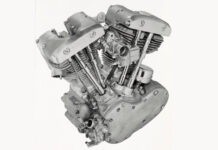Seems to me—not that I like it—it’s high time to discuss those possible (not probable) frailties inherent in Harley’s Cruise Drive. Not being a drive train engineer, rather as an interested observer and student of the strange and wonderful, I can only offer my thoughts. Actually, several of

them—maybe a half dozen or so. So, how about we call this little treatise—Ah!—“Six on six”?

ONE—The bearing isn’t the perpetrator; it’s the victim.
Literally, “caught in the middle” of the behavior of the other components, the purpose of the this unique double-roller design, in my honest opinion, is to serve as a stressed-out “referee” in the ongoing contest the other players on the team throw at it. I believe that if the other issues were addressed the bearing would be trouble free. As it is, it gets blamed for issues beyond its control… a bad call.
TWO—There’s the decidedly “vintage” layout of Big Twin trannys…
…which just might turn out to be the root cause of many an issue in the latest design. Unlike almost any other modern motorcycle (even Sportsters), Big Twins have the clutch and the sprocket hung off the same side of the machine and, more importantly, the lengthy shaft upon which the clutch resides, in all its hefty glory, runs inside the stubby, hollow output shaft (main drive gear in Harley-speak) where the drive belt sprocket is mounted. Even supported as they are, by bearings in strategic locations, the fact is torque and tension can flex the clutch shaft. Any notable degree of flex can “point load’ several locations along the length of the shaft—including the bearing.
THREE—The helical gear design adds side-to-side “shuffle.”
This is more of a factor than generally recognized. Controlling the amount of lateral movement and pressure, in

both directions, is important. For one illustration of this, there’s the phenomenon known as “ghost lever” and you can see for yourself how it works by starting from low rpm in second or third gear, then going right to WOT, then “chopping” (backing off) the throttle sharply. Then watch the clutch lever flip and twitch in and out from the handlebar. This is the helical gear set jerking shafts (and everything else) in the transmission left and right in the case. It’s no accident that the factory has changed the spec of the trap door bearings for ’12 and later models (P/N 8970A)—reducing the axial motion the bearings will allow. It may not be a cure, but it addresses a hell of symptom.
FOUR—Gears made on the shaft adds (or creates) a “barbell” effect.
I’m speculating a bit here, but I’m not the only one, since Bert Baker (Baker Drivetrain) is on record that a direct drive six-speed doesn’t need to have extra gears in mesh (and along for the ride) when one would do. Although it’s not an uncommon practice in automotive designs, this notion of making gears part of the shaft is new to Harley transmission design—in a transverse application. With a heavy unbalanced clutch swinging from one end and several meshed gears thrashing around on the other, it’s reasonable to believe that there’s a lot of flailing going on in all directions and at both ends. Perhaps too much?
FIVE—Automatic tensioners might be too tense and cush drives and compensators aren’t a cure.
The Cruise Drive Transmission appeared first on 2006 Dyna models—only! In 2007 it was an across-the-board feature on all Big Twins, along with a newly re-engineered compensator setup. Aside from any other perceived benefits, it was quite obvious that attempts at softening up the shock loads in the drive train were part of the package. Many thought it was too soft. Yet by 2008, there was a provision to further soften shock loads on ’07 and ’08 Touring models—at the other end—by installing a rear-wheel “cush drive” (called Isolated Drive by Harley) that looked to borrow quite heavily from similar Asian designs, yet seemed to do the trick—if doing the trick meant taking the heat (and the hit) off the primary drive and, hence, the gearbox shafts. An improved version became standard equipment for 2009-present baggers. A note here: counter-balanced TC Softails and the much lighter (and more lightly loaded) Dyna models have no such recourse, but they can improve the compensator action by using the so-called “Screamin’ Eagle/Tri-Glide/’11 and later Touring” version.

All well and good—until you speculate, as I and others have, that the real culprit in drive line shock loads might just turn out to be the automatic primary chain tensioner! Old timers can attest to the fact that careful balancing of the tension between the primary chain and the rear drive chain/belt has always had a notable effect on the operation and reliability (not to mention the oil-tightness) of the main drive gear and inner primary bearing. When you think about the tremendous hammering and whiplash flexing that entire assemblage we refer to as the “drive train” goes through with every hard shift, you can grasp the critical dynamics involved. When primary chains were matched to drive chains, there were few issues if both were correctly adjusted. It got a lot more interesting and intricate with the introduction of rear belts, since they basically don’t give at all—and don’t give a damn! Still, a proper manual adjustment reduced the likelihood of any real problems. On the other hand, the so-called automatic tensioner Big Twins have had for the last several years is misnamed—it is a tightener! It cannot loosen! Two things about this fact make me nervous: the “Auto-T” can get too tight by accident, and too tight is too hard on the drive train… for all the reasons we have just mentioned.

SIX—Isn’t the clutch basket too “cantilevered?”
The largest, heaviest mass operating in the drive (and on the shaft) is the clutch… right? Well, what if that mass was too far out to spin with real stability? After all, it’s easier to spin a mass smoothly from the middle than from one end. Well, the bearing in the clutch basket is near flush with the ring gear and I know of at least one manufacturer of aftermarket high-performance clutch parts that moves said basket bearing quite a bit further towards the middle of the assembly—to good purpose! I suspect doing that decreases the tendency of the clutch to try and toss those four spinning gears (made on the shaft, remember) off the other end! It probably keeps the poor tormented double-row bearing in the middle from dealing with as much to-and-fro/side-to-side/fore-and-aft, “herky-jerky” behavior as well. But that’s just my opinion… I could be wrong.




















